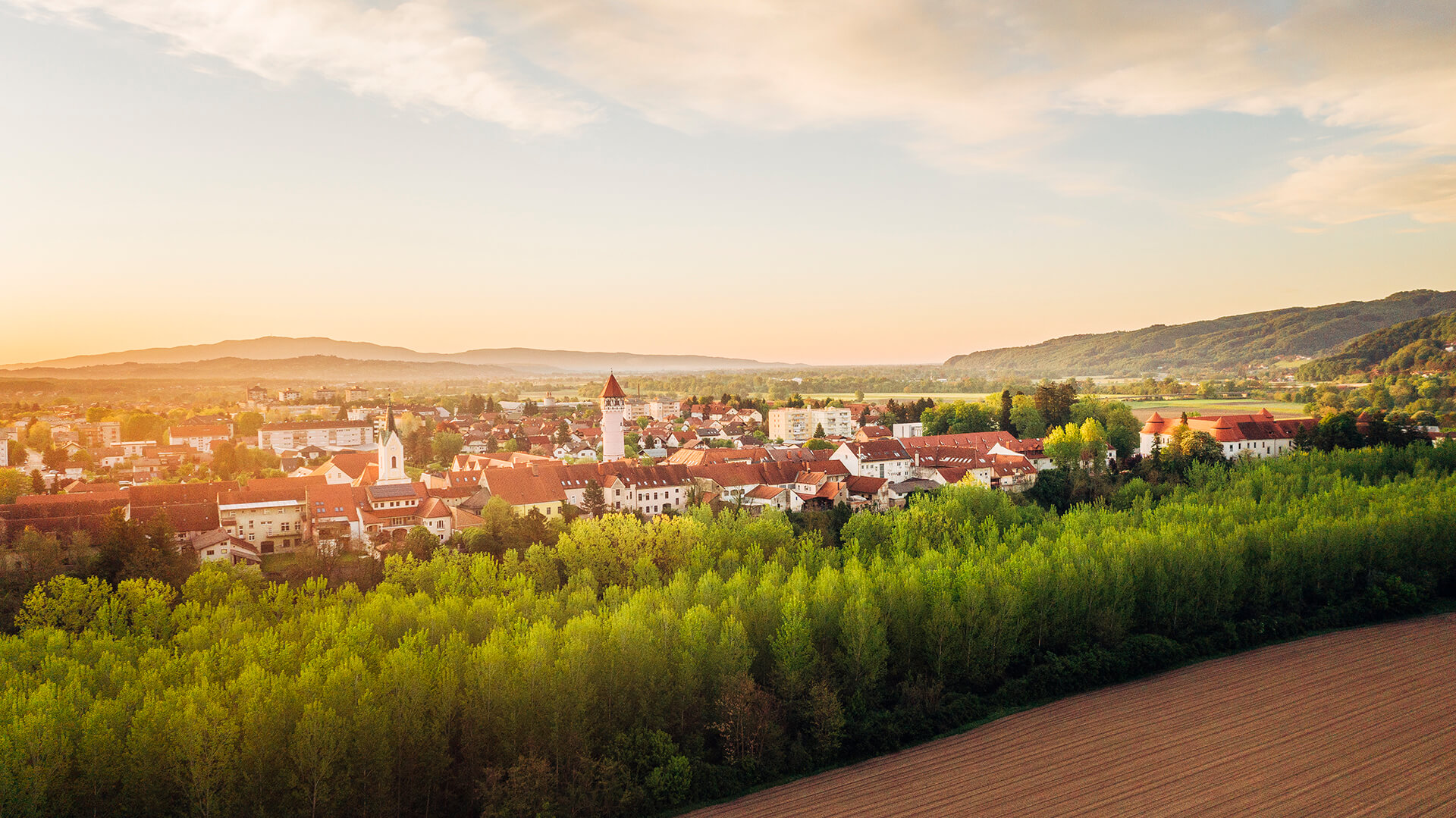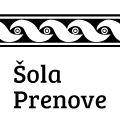Among houses of craftsmen and traders
Stroll through the times of castles and trading, building of artisan houses along the town walls, and the construction of the exceptional iron bridge across the two rivers. Discover the energy points on the way to the views nearby.
Welcome to the Town house
Start your tour of the old town at the Town Hall (1). Here is the Tourist Information Centre with all the information and inspiration for your wanderings around Brežice and its surroundings. The shop with local products gives you the feel of the character of this town between Styria and Carniola, while the wine shop boasts wines and sparkling wines of the Posavje wine-growing region. On the façade of the Town Hall there is a memorial plaque dedicated to Radoslav Jakob Razlag (2), one of the men who influenced the life in the town and Slovenia.
Among houses of craftsmen and traders
As you look towards the castle from the Town Hall, the view is attracted by the old pharmacy (3), the oldest preserved house in Brežice. Find the year on the portal! As you walk north along the main town street, observe the houses of artisans and merchants (4) with workspaces on the ground floor. Stop at the house of the Del Cott family (5), one of the most interesting burgher houses in Brežice. On the opposite side of the street, there is the Parish Church of St. Lawrence (6) with famous frescoes and a rosette adorning the picturesque façade.
To the National House and the German House
At the beginning of the 20th century, two mighty new buildings competed on the main street of Brežice. The renovated National House (7), which does not reveal its original meaning on the outside, was a cultural and political centre of the Brežice Slovenes. A little further on, on the other side of the street, there is the German House (8), where the Brežice Germans used to gather. In front of the German House, a look of the floor reveals another era. The paving stones here mark the course of the town walls and the position of the former northern town gates (9).
A Tip: Stop in Vrtnica café opposite the National House or in a nearby Splavar restaurant and treat yourself to a lunch with typical flavours of Posavje.
To the Trg izgnancev square and the monastery school
A monument to the exiles (10) and a street exhibition about the deportation of the Posavje people during the WWII remind us of a recent period of foreign rule. On Trg izgnancev Square, there is also a former Franciscan monastery (11), where the Brežice Grammar School now operates. From here, the pilgrimage church of St. Rocco (12) can be seen. This patron saint of artisans and craftsmen was once honoured with a great fair.
A Tip: Opposite the Brežice Grammar School there is the Ošterija Debeluh restaurant. Chef Jure Tomič, who was awarded with the international Michelin gastronomic award, spoils the palate with exquisite culinary delights.
Among gardens to the Water tower
After visiting the northern part of the town, turn left behind the Vrtnica café and walk along Ulica stare pravde Street, which runs along the former town wall. The remains are visible at the post office building. On the left side, there are gardens, cultivated by the townsfolk. Before you rises the Water Tower (13), by far the most visible landmark of the town. It improved the town’s water supply in the early 20th century. In the park between the Water Tower and the municipal building, where there used to be a market, the people of Brežice had a bomb shelter before the Second World War.
Along the most beautiful street up to the two rivers
As you continue along Ulica stare pravde Street you reach Gasa (14) – a part of the street with clustered artisan houses built onto the old town wall, which is visible at the back.
Many consider Gasa the most beautiful part of the town! It brings you into the shade of the centuries-old trees of the town park (15). After a short stop in the park, continue along the tree-lined street to the iron bridge (16). Take a walk along the restored bridge that leads across the two rivers, the Krka and the Sava, which join a hundred meters lower. On the way, learn about Brežice and life with a river from the street billboards.
A Tip: If you continue your walk over the bridge, you will reach Lake Brežice, the second largest accumulation lake in Slovenia, which the locals call ‘the sea’.
At the lake, continue towards Vrbina, a former floodplain of the Sava bend. Many birds live in the former forest.
Stories of the castle and the Knight’s hall
When you return from the river bank – either along the same path or through the poplar forest in Vrbina, – head to Brežice Castle – the Posavski Museum Brežice (17). Even before you enter the castle, the paving in the floor along the NE tower of the castle shows where the defensive wall was connected to the town wall. Visit the Knight’s Hall with its exceptional baroque paintings and exhibitions of the Posavje Museum Brežice (18), which take you through the Posavje hills and plains – from prehistory to modern times. After experiencing medieval stories, return to the starting point of your hike past the castle granary (18) and the castle stables (19).
A Tip: Before you leave the castle area, stop at Yogurtlandia.
Sum up the impressions of Brežice over tasty frozen yoghurt.
Suggestions for a hike
Along the Čatež energy path to a viewing point
The Church of St. Vitus, which sits on a slope, can already be seen from the town centre. Vida. Šentvid (386m) is a popular viewing point among hikers. Take the 9-kilometre route from the town past the iron bridge and the confluence of the Sava and the Krka.
When you arrive to Čatez ob Savi, follow the marked Čatež energy path. Over 15 energy points, which are also visited by barefoot hikers, take you to the top of the lookout hill. At the top is the Romanesque church of St. Vitus, where you can ring the wishing bell. From the church, there is a beautiful view of the Krško-Brežiško plain, the old town of Brežice and Lake Brežice. If you continue your way towards the village, you will also see Terme Čatež, the largest spa complex in Slovenia.
More information: Brežice TIC
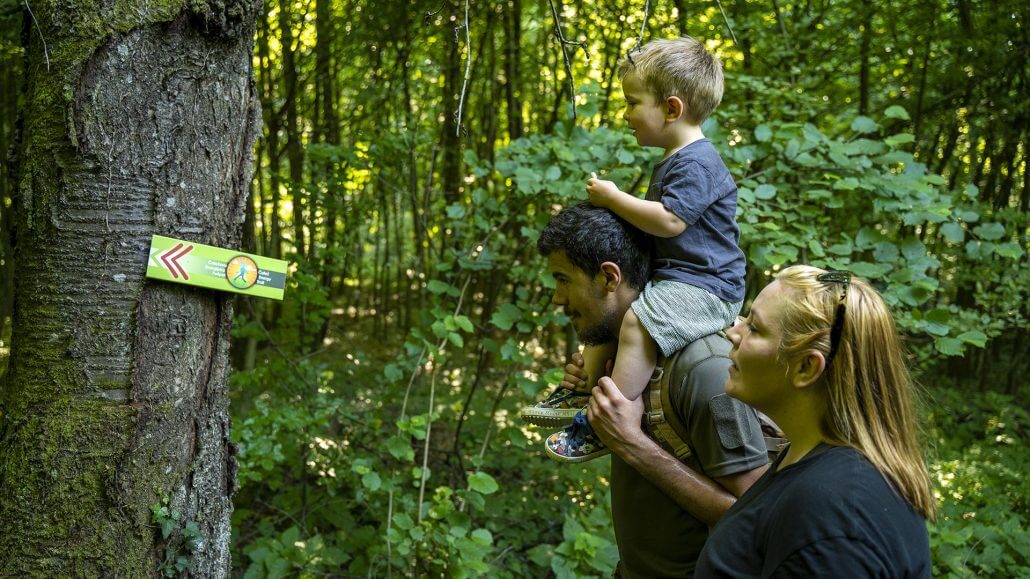
1. The Town Hall
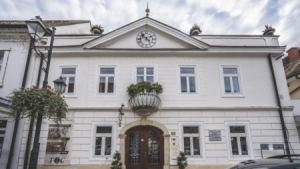
The late Baroque Town Hall from the 18th century, also called ‘magistrat’, has a prominent central axis and a stone portal with the coat of arms of Brežice and the year 1769.
Upstairs there is an attractive balcony with a vase-shaped baroque balustrade. The building has an architecturally interesting roof extension with a triangular front and a painted clock in the middle. In the second half of the 19th century, various town offices operated here.
Cesta prvih borcev 22, T: 07 49 66 995
2. A Memorial plaque to Radoslav Jakob Razlag
Radoslav Jakob Razlag (1826–1880) was a writer, poet and politician. He was the first Slovenian to be elected to the Styrian Provincial Assembly in 1865. Six years later, in 1871, he was the first Slovenian to become a governor of the crown land of Carniola. In Brežice, he worked as a lawyer and a caretaker of Brežice Castle. He was also among the organizers and speakers at the large Sevnica rally in 1869, one of the most important events of the political movement which sought for a United Slovenia.
Town Hall, Cesta prvih borcev 22, T: 07 49 66 995
3. The Old pharmacy
The oldest preserved house in Brežice with a Renaissance façade has a semicircular portal from 1641 and 1695. There is an interestingly twisted chimney on the roof.
On the ground floor, there are three semicircular trade portals with neo-baroque iron gates. In a semicircular niche upstairs is a statue of Mary from the second half of the 18th century. From the end of the 18th century until the second half of the 20th century, there was a pharmacy in the house, but now there is a restaurant in it.
Cesta prvih borcev 15
4. Houses of artisans and merchants
Brežice developed along the lively commercial waterway at the Sava River. It was known as an important fair, commercial and craft town. Craftsmen made up the majority of the town’s population. The commercial importance of the town began to grow in the 18th century. Livestock, pig, timber and haberdashery fairs were held here. The people of Brežice traded in a wide variety of goods. Many traders had their ports on the former bend of the Sava.
Cesta prvih borcev
5. The House of the Del Cott family
The stone portal of this house from the second half of the 18th shows the name Cott engraved along the year 1782. The iron window shutters have the initials of his name along the year 1790. The family Del Cott had a shop in the building. Leonhard Del Cott , who moved to Brežice from Italy, arranged storage space under the house for goods that arrived on the Sava, which flowed under the houses on the west side of town. The Del Cotts were the richest and the most prominent family of that time in Brežice.
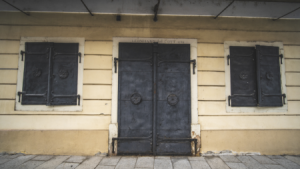
Cesta prvih borcev 23
6. The parish church of St. Lawrence
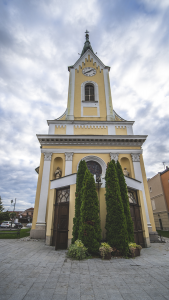
Poznobaročna cerkev s slikovito fasado, členjeno s pilastri, nišami in rozeto, zgrajena leta 1782, ima v notranjosti poslikave Tomaža Fantonija in Jakoba Brolla iz sredine 19. stoletja. Prezbiterij iz leta 1966 je delo Staneta Kregarja. V stranskih oltarjih sta sliki sv. Miklavža in sv. Florijana, v spomin na cerkvi sv. Miklavža in sv. Florijana, ki ju je uničila povodenj leta 1781. Poplave so izpodjedle tudi temelje stare župnijske cerkve, prvič omenjene leta 1297, ki je stala na nasprotni strani ulice.
Cesta prvih borcev 34
7. The National House
At the end of the 19th century, the Slovenes, who united in the national-cultural society called čitalnica, chorus and a tamburitza choir also established their own loan company. They gathered in the garden and in the hall of the Klembas Hotel. In 1904, the building was upgraded to a two-storey building with a touch of Neo-Renaissance and Art Nouveau. The new National House with a big inn room, tourist rooms, a large hall with a stage and a garden, a glass lounge and a veranda was a cultural and political centre of the Brežice Slovenes.
Cesta prvih borcev 39
8. The German House
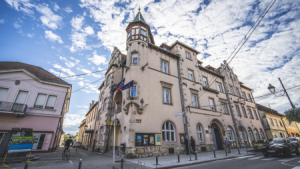
In 1904, on the north side of the former town wall, the German House was built in a typical German – Renaissance style, and a Black Eagle Hotel. An organization that promoted German culture with concerts, dances and other events operated here till the end of the First World War. In the early 20th century, the building housed the court, post office and tax administration. It now houses a court and part of it is privately owned.
Cesta prvih borcev 48
9. The North town gate
Brežice, which has had town rights since 1353, was given a new, more extensive wall in the 16th century. An important part of the wall with the moat, up to 30 meters wide, was the north town gate with a basement tower. At the town gate, arrivals and departures of people, vehicles, goods and animals were monitored. The course of the town wall at the north gate can be seen on the street at the German House.
markings in the paving in front of the German House, Cesta prvih borcev 48
10. A Monument to exiles
The fountain-shaped monument is dedicated to those who died in exile during World War II. The author of the monument, erected in 2001, is the architect Franc Filipčič. Near the monument is a street exhibition of photographs on billboards, which represent events during the Second World War, when around 37 thousand or as much as 86 % of people were expelled from the Sava and the Sotla area.
Trg izgnancev
The Franciscan monastery - Brežice Grammar School
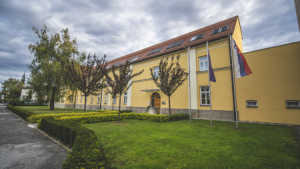
The Franciscans built a monastery next to the northern town wall in the 17th century and then added a Baroque church to it. From 1699, boys from bourgeois families were educated here, and in 1870 the first secular teachers began to teach. The monastery building was rebuilt after the 1917 earthquake. During World War II, the Germans disbanded the monastery and demolished the church. After the war, the Brežice Grammar School began to operate in the building.
Trg izgnancev 14
12. The church of St. Rocco
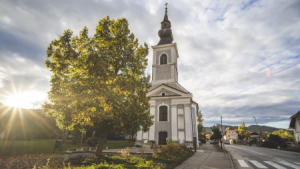
The pilgrimage church at the northern entrance into the town dates back to the 17th century. It is consecrated to St. Rocco, the protector against infectious diseases and the patron saint of artisans and craftsmen. Pilgrims added wax and wooden votive objects, often in the shape of hands, to their health requests. Before the Second World War, Brežice was most festive on 16 August, on the day of St. Rocco, when the main town street turned into a lively fair ground with stalls with various craft products for sale.
Cesta bratov Milavcev 2
13. The Water tower
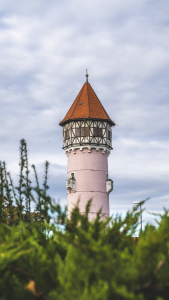
The 46-meter-high tower, the most visible town landmark, invites you to Brežice from afar. It was built in 1914. The octagonal water collector on top is ensuring an adequate water pressure in the water supply network. The tower, built in the romantic style of the German Renaissance, has wooden ornaments in the shape of a heart. They were a symbol of love of a high Austro-Hungarian official to a local Brežice woman. The municipality intends to turn the tower, which has not performed its role since 1983, into a lookout point, where you will also learn about the “water stories”.
Bizeljska cesta 4
14. Gasa
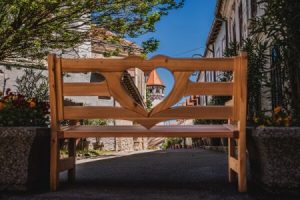
A street of artisan houses connects the water tower and Brežice castle. The houses were built onto a former east town wall from the 16th century, which was 6.6 m high and almost 2 m wide. From the outside the wall was surrounded by a moat. In the past centuries, blacksmiths, locksmiths, potters, tailors, shoemakers, house painters, watchmakers, carpenters, butchers, saddlers and upholsterers worked in the houses along the wall. The first Brežice public hospital has also been here since 1872.
Ulica stare pravde
15. Town Park
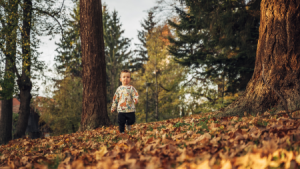
The Attems family, which had owned Brežice Castle, arranged the castle park in the English landscape style of the 19th century. The seedlings for interesting park trees came from the tree nursery of Miramare Castle near Trieste. The largest trees in the park, with a circumference of more than 4 meters, are the London plane and the tulip tree. There are playing equipments for children and a short educational path in the park. At the edge of the park are outdoor fitness equipments.
between the streets Dobovska cesta and Pod obzidjem
16. The Iron bridge
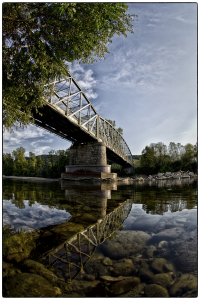
The reinforced concrete bridge at the confluence of the Sava and Krka rivers, built in 1906, was one of the longest in the then country at 524 meters. It consists of two iron bridges. The bridge over the Sava has two arches and the bridge over the Krka has one. It is completed at both ends by an Art Nouveau wall fence. A bridge toll had to be paid for the crossing of the bridge that connected Styria and Carniola until the Second World War. The bridge, rebuilt between 2020 – 2021, is a cultural monument of local importance and remarkable technical achievement of that time.
Prešernova cesta
17. Brežice Castle
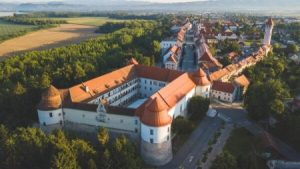
The original castle from the 12th century was damaged and burnt several times in the 16th century. It was most hit in 1515 during the biggest Slovenian peasant uprising.
In 1529, the construction of a new Renaissance fortress with four defensive towers, two walls, a moat and a drawbridge began. In the 18th century, the noble Attems family turned the castle into a mansion. The Knight’s Hall boasts unique paintings with rich mythological content. The paintings on the staircase depict five senses while the paintings in the chapel create a convincing illusion of space. The Posavje Museum Brežice has been operating in the castle, which is a monument of national importance, since 1949.
Cesta prvih borcev 1, T: 07 466 05 17
18. The Posavje Museum Brežice
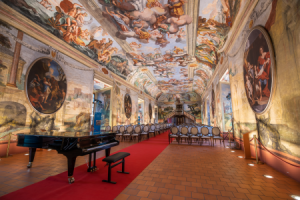
The museum, which has been operating in Brežice Castle since 1949, presents the heritage of the Posavje region from its earliest days to the present day. There is a permanent archaeological and ethnological exhibition and also an exhibition about peasant uprisings, the Posavje Protestants, about the life of wealthier townspeople at the turn of the 19th and 20th century and about the developments in the recent history of Posavje.
When visiting the museum, you can also see the famous Knight’s Hall, the staircase and the chapel.
Cesta prvih borcev 1, T: 07 466 05 17
19. The Granary
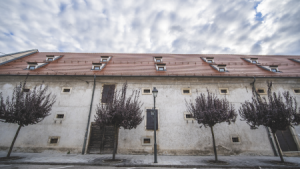
The now mighty castle granary, which was built at the beginning of the 18th century, stands on a site of a granary that was first mentioned in 1491. In the first half of the 19th century, the Brežice upper class held underground wine cellars here. Wine was produced for them by the best local winemakers. The granary in Brežice is one of the best-preserved castle granaries in Slovenia and is a cultural monument of national importance.
Cesta prvih borcev 4
20. The Castle Stables
The former castle stables stand where the stables were built as early as the 16th century.
In the middle of the 19th century, the buildings on the left side of the street were called the Riding School. On the ground floor of the first building were stables, in which horses were bred for harness and for personal and freight traffic.
The room with the ceiling arches and colonnades is now a hall of the Brežice Music School that operates in this interesting building.
Cesta prvih borcev 5
- 11. The Town Hall
- 22. A Memorial plaque to Radoslav Jakob Razlag
- 33. The Old pharmacy
- 44. Houses of artisans and merchants
- 55. The House of the Del Cott family
- 66. The parish church of St. Lawrence
- 77. The National House
- 88. The German House
- 99. The North town gate
- 1010. A Monument to exiles
- 11The Franciscan monastery - Brežice Grammar School
- 1212. The church of St. Rocco
- 1313. The Water tower
- 1414. Gasa
- 1515. Town Park
- 1616. The Iron bridge
- 1717. Brežice Castle
- 1818. The Posavje Museum Brežice
- 1919. The Granary
- 2020. The Castle Stables


